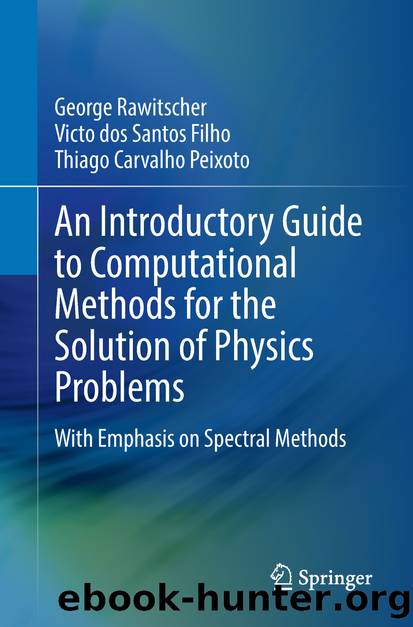An Introductory Guide to Computational Methods for the Solution of Physics Problems by George Rawitscher & Victo dos Santos Filho & Thiago Carvalho Peixoto

Author:George Rawitscher & Victo dos Santos Filho & Thiago Carvalho Peixoto
Language: eng
Format: epub
ISBN: 9783319427034
Publisher: Springer International Publishing
8.3.1 The Iterative Method of Seaton and Peach
The iterative method of Seaton and Peach [1] consists in rewriting Eq. (8.5) in the form
(8.7)
where
(8.8)
and calculating the solution of Eq. (8.7) by means of the iteration [1]
(8.9)
Here n denotes the order of the iteration. The initial value of y is given by the WKB approximation [4, 5]
(8.10)
The advantage of formulating the iteration according to Eq. (8.9) is that y varies slowly with r, automatically and adiabatically approaching unity at large distances, and hence is small compared to w. Near the origin of r this term may become large, and the iterations may not converge. In that case the solution of Eq. (8.9) should be started at a point sufficiently far from the origin, in a region where [ is sufficiently small compared to w, depending on the accuracy desired, as will be described further below. A feature of the present Ph-A method is that no initial conditions are required to be imposed. Since the potential in Eq. (8.8) approaches zero asymptotically, the amplitude y automatically approaches unity, asymptotically. This last property is very important, since the wave function derived from the present Ph-A method automatically also has unit amplitude asymptotically, even though the calculation is not required to be performed to asymptotic distances. This property does not hold for finite element or finite difference calculations. Equation (8.6) combined with the first order result is equivalent to the WKB approximation.
In summary, the iteration scheme (8.9) provides a method to iteratively improve the WKB approximation, since after convergence the resulting wave function is in much better agreement with benchmark wave functions than the WKB result for the numerical cases studied below.
Download
This site does not store any files on its server. We only index and link to content provided by other sites. Please contact the content providers to delete copyright contents if any and email us, we'll remove relevant links or contents immediately.
The Complete Stick Figure Physics Tutorials by Allen Sarah(6638)
Secrets of Antigravity Propulsion: Tesla, UFOs, and Classified Aerospace Technology by Ph.D. Paul A. Laviolette(3448)
Thing Explainer by Randall Munroe(3327)
The River of Consciousness by Oliver Sacks(2992)
The Order of Time by Carlo Rovelli(2714)
I Live in the Future & Here's How It Works by Nick Bilton(2524)
How To by Randall Munroe(2474)
A Brief History of Time by Stephen Hawking(2473)
The Great Unknown by Marcus du Sautoy(2186)
What If?: Serious Scientific Answers to Absurd Hypothetical Questions by Randall Munroe(2170)
Blockchain: Ultimate Step By Step Guide To Understanding Blockchain Technology, Bitcoin Creation, and the future of Money (Novice to Expert) by Keizer Söze(2137)
Midnight in Chernobyl by Adam Higginbotham(2078)
Networks: An Introduction by Newman Mark(1998)
The Meaning of it All by Richard Feynman(1909)
Easy Electronics by Charles Platt(1864)
The Tao of Physics by Fritjof Capra(1848)
When by Daniel H Pink(1777)
Midnight in Chernobyl: The Untold Story of the World's Greatest Nuclear Disaster by Adam Higginbotham(1775)
Introducing Relativity by Bruce Bassett(1754)
